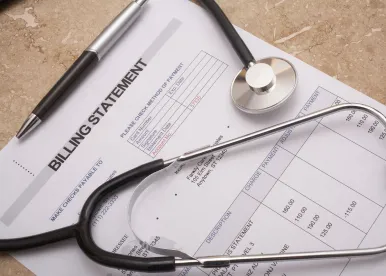The No Surprises Act was signed into law in late 2020 after years of negotiation between health plan insurers, employers, and providers regarding the elimination of “surprise” medical bills. The bill represents a sea change in the way that providers can bill and be reimbursed for “out-of-network” services. This update provides an overview and analysis of the law and recent legal challenges to a portion of the law.
Background: The No Surprises Act is intended to eliminate surprise medical bills often received by patients from medical providers that are not part of an insurance plan’s or other payor’s preferred network of providers. This is often referred to as “balance billing” because the out-of-network provider bills a patient directly for the part of the bill that is not covered by insurance (the balance). Often, patients will assign their right to collect from the payor to the provider and the provider attempts to recover directly from the payor.
Elimination of Surprise Bills: The law eliminates surprise medical bills in three primary circumstances, by limiting the amount that a patient must pay to the in-network cost and cost-sharing requirements of the applicable health plan or policy.
-
Patients who receive emergency medical services from out-of-network providers. In this circumstance, patients can only be billed in accordance with in-network cost sharing requirements from the patient’s initial evaluation until stabilization. The law applies the limitation on surprise billing to emergency services provided at hospitals, free-standing emergency departments, and urgent care centers that are licensed to provide emergency care. Emergency services include post-stabilization care until a physician determines that a patient can travel safely via non-emergency medical transportation.
-
Patients who receive non-emergency services at an in-network facility. This circumstance arises when out-of-network providers such as anesthesiologists or radiologists do not have a contractually negotiated rate with the facility where a patient is receiving treatment. The law applies the limitation to a host of facilities, including hospitals, hospital outpatient departments, and ambulatory surgical centers. Notably, urgent care centers, birthing centers, hospices, addiction treatment facilities, and nursing homes are not included for purposes of the non-emergency services limitation.
-
Patients receiving air ambulance services. Patients may utilize the services of air ambulances, which has traditionally given rise to significant balance bills.
Notice and Consent to Balance Billing: There is a limited circumstance where a provider can balance bill a patient for the services described above. If a provider furnishes notice to a patient and the patient consents to receiving a balance bill, then the billing protections under the law do not apply. Consent for balance billing cannot be provided in the following circumstances:
-
Emergency services
-
Treatment for emergency medicine, anesthesiology, pathology, radiology, and neonatology
-
Treatment provided by assistant surgeons, hospitalists, and intensivists
-
Treatment for diagnostic services, including radiology and laboratory services
-
Services provided by an out-of-network provider if there is no in-network provider at the facility where the patient is being treated
Dispute Resolution Process: The law does not specify who bears responsibility for the cost of the care that is not otherwise covered by insurance or other forms of reimbursement arrangement (e.g., Medicare, Medicaid). In anticipation of disputes that will undoubtedly arise between providers and payors, the law provides for a mandatory independent dispute resolution process.
Under this process, the parties have 30 business days to negotiate a payment amount. If the negotiation fails, then either party may invoke binding arbitration within four business days from the end of the 30-day negotiation period. At that point, an independent arbitrator will be selected. Under the arbitration process, each party must submit a final written offer and supporting documentation for the disputed amount. The arbitrator must select one of the two written submissions — there is no ability for the arbitrator to select a different amount.
The law directs the arbitrator to consider various factors in determining an appropriate rate: (i) the median of the contracted rates recognized by the plan or insurer as of January 31, 2019, for the same services in the same geographic region (this is referred to as the qualifying payment amount); (ii) the provider’s level of experience and expertise; (iii) the parties’ respective share of the market for such services; (iv) case mix and scope of services traditionally performed at the facility; and (v) demonstration of good faith or lack thereof in contracting with the plan or payor. There is a rebuttable presumption that the amount closest to the “qualifying payment amount” should be selected.
Patient Disclosures: Providers and facilities must publicly post a written disclosure explaining the protections of the No Surprises Act. Further, providers and facilities must provide notice to a patient or beneficiary when payment is requested for balance billing or when a claim is submitted to a payor. The required disclosure must contain an explanation about the balance billing prohibitions, relevant state law requirements prohibiting balance billing (if any), and contact information for federal and state agencies that enforce the law.
Enforcement: The Act contains enforcement provisions similar to those under the Affordable Care Act and HIPAA, meaning that states will continue to regulate fully insured group medical plans and the US Department of Labor will regulate self-insured plans. The federal enforcement provisions provide for civil monetary penalties up to $10,000 per violation and the creation of a federal process to receive consumer complaints related to surprise medical bills. States can enter into collaborative enforcement agreements with the federal government, which would cede some enforcement authority to federal agencies if states cannot reach voluntary compliance with a violator.
Litigation: On February 23, 2022, a federal court vacated a provision of the interim final rule concerning the dispute resolution process. Specifically, the court found that the US departments of Health and Human Services, Labor, and the Treasury exceeded their authority by instructing independent dispute arbitrators to favor some factors over others in determining the “qualifying payment amount.” In response to the litigation, the departments issued a memorandum withdrawing the vacated provision and indicating that arbitrations should not otherwise be affected by the court’s decision. According to the memorandum, the departments intend to proceed with opening the arbitration portals and will consider “next steps” related to the court decision.





 />i
/>i

